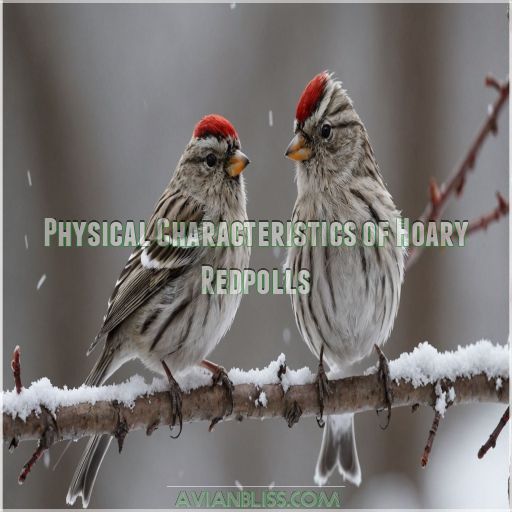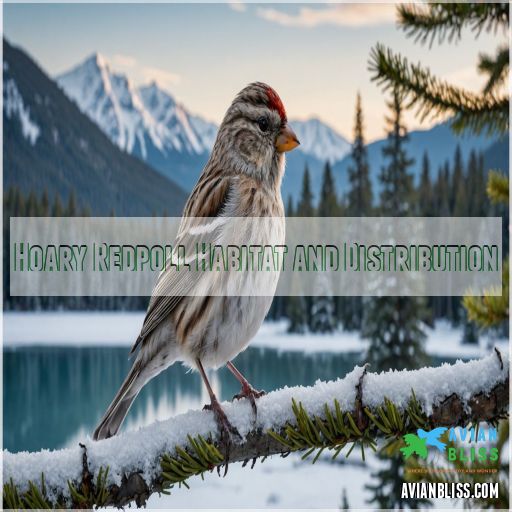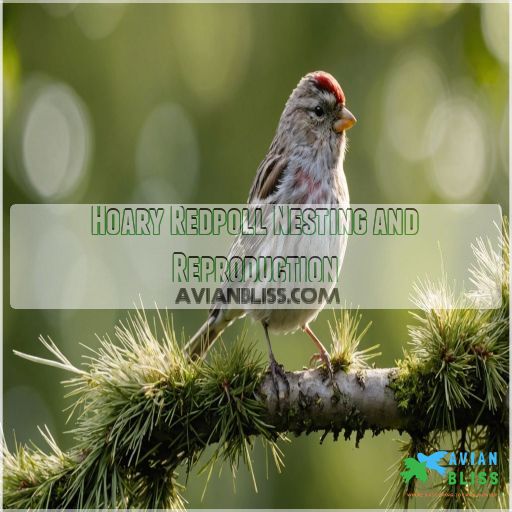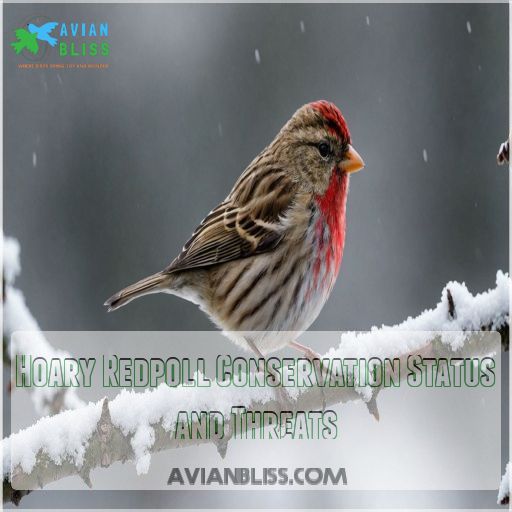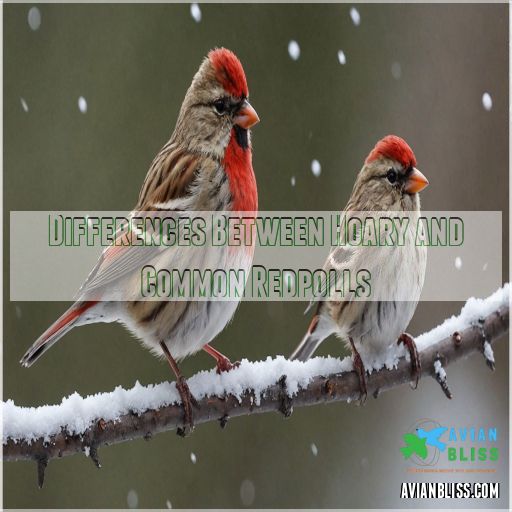This site is supported by our readers. We may earn a commission, at no cost to you, if you purchase through links.
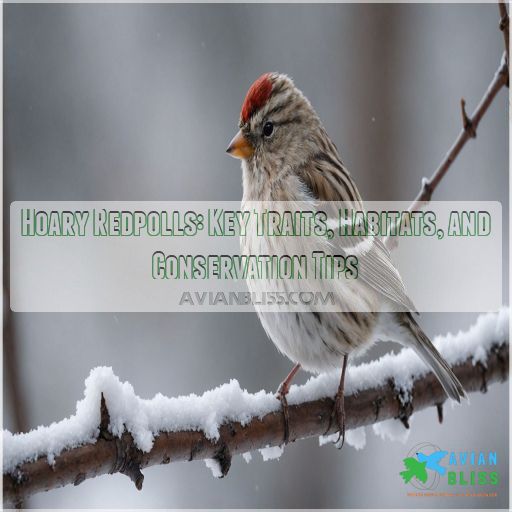
You’ll often find them darting around the tundra in search of tiny meals or hanging upside down on branches like feathery gymnasts. Their adaptable diet includes seeds, insects, and spiders, allowing them to thrive in harsh conditions.
Curious about their nesting or perhaps their differences from the Common Redpoll? There’s more to these fascinating little survivalists than meets the eye, and they have a frosty plumage and a stubby bill.
Table Of Contents
- Key Takeaways
- Physical Characteristics of Hoary Redpolls
- Hoary Redpoll Habitat and Distribution
- Behavior and Diet of Hoary Redpolls
- Hoary Redpoll Nesting and Reproduction
- Hoary Redpoll Conservation Status and Threats
- Differences Between Hoary and Common Redpolls
- Identifying Hoary Redpolls in the Field
- Frequently Asked Questions (FAQs)
- What is a hoary redpoll?
- What does a hoary redpoll look like?
- Are hoary redpolls the same as common redpoll?
- Do hoary redpolls breed?
- What is the difference between hoary redpolls and Common Redpolls?
- Where do hoary redpolls live?
- What is the difference between a purple finch and a red pole?
- What bird feeder does a common redpoll eat?
- How do weather conditions affect redpoll migrations?
- What changes does climate change cause in redpoll behavior?
- Are there specific plants important for hoary redpolls?
- How do redpolls adapt to their arctic environment?
- Do redpolls have any cultural significance or meanings?
- Conclusion
Key Takeaways
- Spot the Snowflake: When you’re out looking for Hoary Redpolls, imagine finding a rare snowflake among birds. Their frosty plumage and stubby bills set them apart from their Common Redpoll cousins, so keep your eyes peeled for these unique Arctic trekkers.
- Winter Survivors: These little acrobats don’t just survive; they thrive in the harshest conditions. Picture them swinging upside down from branches, munching on seeds from birch, alder, and willow trees. They adapt their diet to whatever’s available, showing true survival savvy.
- Home Among the Tundra: Think of their habitat as the Arctic’s open tundra—like a real estate market with sparse shrubs and lots of elbow room. They build sturdy nests from twigs and feathers, finding cozy spots in this chilly expanse, proving they’re not picky when it comes to nesting.
- Climate Challenges: Just as you can’t find your winter coat in a cluttered closet, they face shifting homes due to climate change. These fluffy wanderers need a helping hand from conservation efforts to keep thriving in their frigid landscapes.
Physical Characteristics of Hoary Redpolls
When you first spot a Hoary Redpoll, its pale, frosty coloring sets it apart from its Common Redpoll cousins.
You’ll also notice its stubby bill, and its softer pink chest, making it easy to distinguish from its feathery relatives.
Comparison to Common Redpolls
Imagine a cold snap in the Arctic, where you spot a Hoary Redpoll. These birds, scientifically named Linota hornemanni, have a frostier appearance than their cousins, the Common Redpoll (Acanthis hornemanni).
You’ll notice smaller, stubby bills and lighter color patterns.
Vocalizations may differ slightly, adding another layer to their subtle distinctions, especially in their Vocalizations.
Distinguishing Features
To spot a hoary redpoll, notice its distinct "frosty" plumage—a subtle blend of white and beige that’s lighter than the Common Redpoll’s.
Look for a compact bill that seems almost tucked into their fluffy feathers, unlike its cousins’ bills.
These redpoll variations are an example of mixing art with nature, much like wearing winter fashion.
Size and Plumage
Awash in hues of soft gray and white, hoary redpolls sport a larger size than their common cousins and showcase distinct plumage variations.
You might chuckle, comparing their fluffy, winter plumage to a cozy, oversized sweater.
These birds’ molting patterns and identification challenges become evident in shifting seasons, affecting their continental concern score as climate change reshapes their habitats.
Bill Shape and Size
After observing their small, fluffed-up plumage, you’ll notice hoary redpolls sport a stubby bill, uniquely shaped for cracking seeds, a life-saving trait in their remote arctic habitats.
Smaller than a house finch but more robust than a golden-crowned kinglet, their bills appear almost pushed in, showcasing adaptations like slotting seeds from rocky crevices in Baffin Island , demonstrating their ability to access seeds in tight spaces with their uniquely shaped bills, a crucial adaptation for their remote arctic habitats and their specific method of foraging, such as slotting seeds.
Color Patterns and Markings
Spotting a Hoary Redpoll among stunted trees is like finding a snowflake in a flurry.
Males flaunt pale plumage variations with a pinkish breast, while females sport subtle color differences with sparse streaks.
In flights over Baffin Island, their frosty appearance makes them partners in flight, creating a charming dance of winter hues.
Hoary Redpoll Habitat and Distribution
If you think about where hoary redpolls hang out, picture them in the far north’s open tundra with willows and birches lining their nests.
When winter rolls in, they mix with other redpolls, venturing to woodland edges and fields—always on the lookout for seeds amid the cold.
Breeding Grounds in the Arctic
You’ve marveled at their frosty plumage, now picture Hoary Redpolls nesting in the Arctic’s barren expanse.
They embrace the tundra, with scattered shrubs offering nesting spots.
These resilient birds face challenges like climate change impacting Arctic nesting success and their distribution.
Imagine them thriving amid freezing conditions, an inspiring example of adaptation and survival .
Wintering Grounds and Migration Patterns
Hoary Redpolls brave harsh Arctic breeding grounds and wander southward during winter.
Their migration routes lead them to North America’s forests, where they find sustenance among plentiful food sources like seeds.
Climate change impacts their wintering habitat, altering population dynamics as these adaptable birds navigate environmental shifts.
They’re like snowbirds of the avian world, seeking milder conditions.
Preferred Habitats and Landscapes
Imagine wandering through the frozen expanse of the Arctic, where Hoary Redpolls thrive.
Their preferred habitat includes:
- Tundra vegetation, offering ideal nesting sites.
- Open landscapes with sparse trees for protection.
- Abundant food availability from small seeds.
- Resilience to climate change impacts, illustrating adaptable habitat selection.
These feathery wanderers embody survival in extremes.
Comparison to Common Redpoll Habitats
Picture a showdown between habitats! In this corner, Hoary Redpolls nest in upland tundras, favoring solitude and open spaces. In the other, Common Redpolls reside at forest edges.
Read on for a bird’s-eye view:
| Trait | Hoary Redpoll |
|---|---|
| Nesting Site | Upland tundra |
| Food Availability | Scarce, adaptive |
| Elevation Preferences | Higher, barren areas |
You’ll see, they’ve got distinct homes!
Behavior and Diet of Hoary Redpolls
You’d find Hoary Redpolls energetically flipping upside down on branches, hunting seeds, bugs, and even stealing a taste of Arctic catkins.
Imagine them as acrobats of the bird world, their quick movements fueled by a rich buffet of birch, alder, and the occasional insect snack, which provides a rich buffet.
Foraging and Feeding Habits
Hoary Redpolls are masters of adaptability when it comes to foraging. Despite harsh Arctic conditions, they cleverly exploit available food resources.
You’ll find them energetically clinging upside down on branches or hopping on the ground.
Their seasonal diet changes help them survive:
- Resourceful: Extracts seeds efficiently
- Flexible: Accommodates diet overlap
- Cooperative: Tolerates flockmates while foraging.
Types of Food Consumed
You’ve got the Hoary Redpolls skillfully foraging high in the Arctic, balancing on slender branches like circus performers.
Their diet consists mainly of seeds from birch, alder, and willow, emphasizing seasonal variation and savvy dietary adaptations.
These birds handle competition for food with finesse, sometimes clashing with open bills as they feast.
Insect and Spider Consumption
In warmer months, Hoary Redpolls indulge in a diet shift, favoring insects and spiders.
Seasonal variation means prey availability isn’t static, but these birds savor the diversity of insects, perhaps with a special fondness for spiders.
It’s like a buffet, minus the complaints about long lines! This provides essential proteins, fueling the lively lifestyle of these energetic little birds.
Seed and Plant Material Consumption
Hoary Redpolls have a preference for dining on the seeds of birch, alder, and willow trees, along with grasses and wildflowers.
Their diet shifts with the seasons, showcasing their adaptability.
As these charming, fluffy birds munch on seeds, you might say they’re nutritional strategists, ensuring they get the best from their Arctic environment.
Unique Foraging Techniques
Just as seeds and plant material constitute a large part of their diet, hoary redpolls showcase unique foraging techniques. You might find them clinging to branches, skillfully gathering seeds. They’re like aerial acrobats executing upside-down feeding maneuvers, a remarkable adaptation for winter survival in harsh tundra landscapes.
Common redpolls, their relatives, also employ a unique throat pouch to store seeds, aiding in winter survival. They use this specialized pouch to cache seeds, such as nyjer seeds, for later use.
Imagine their tiny resilience, mastering artful moves amid bitter cold!
Hoary Redpoll Nesting and Reproduction
When you’re exploring Hoary Redpoll nesting habits, you’ll notice they aren’t picky about real estate—they can nest in low shrubs or even rocky crevices.
These little architects use feathers and twigs to build cozy nests, where they lay their speckled eggs and raise the next generation with care.
Nesting Territories and Site Selection
Ever noticed how Hoary Redpolls chat while munching? It’s not just their social pantry play.
Expanding to nesting territories, they show a keen sense of nest site fidelity, favoring stunted trees and maximizing nesting success rates, similar to the Northern Cardinal which is known for its year-round residency.
They also tend to choose habitats with abundant food sources, such as sunflower seeds, which are a staple in the diets of many red bird species.
Habitat preferences include high territories where nest density and competition for sites are low, ensuring these resourceful birds find their perfect spot.
Nest Structure and Materials
When selecting a nesting site, consider how Hoary Redpolls craft cozy nests from twigs and soft grasses.
Their nests, often tucked into crevices, are surprisingly sturdy despite their delicate appearance.
You’ll find these nests lined with feathers, ensuring warmth.
Availability of materials like willows and drift logs plays a role in nest construction, showcasing their adaptability .
Egg Characteristics and Clutch Size
From those sturdy nests, Hoary Redpolls often lay four to five eggs, painting with colors like bluish glaucous or pale Niagara green, sprinkled with spots.
It’s like nature’s unique canvas. You’ll find them nurturing a clutch size that champions nestling development and parental care, ensuring those future fluffs are prepped and ready for their Arctic adventures.
Incubation and Fledging Periods
Incubation takes around 12 to 14 days, providing a snug, nurturing cocoon for hoary redpoll eggs.
During this period, the nutrient-rich nestling diet preps chicks for flap toward independence in 11 to 17 days.
Your feathered ‘family members’ face a key phase as they and the comedy of their clumsy first flights.
Parental Care and Nesting Success
You’d think raising hoary redpoll chicks in the Arctic is a breeze!
Yet, parents face challenges like nest predation and making sure chick survival.
To boost nesting success:
- Nest site fidelity helps parents choose safe spots yearly.
- Parental provisioning makes sure chicks grow strong.
- Watch out for brood parasitism, where other birds lay eggs in their nests.
Hoary Redpoll Conservation Status and Threats
You’re probably wondering how climate change and human impact affect the Hoary Redpoll.
Despite a thriving global population, these birds face potential threats from shifting habitats and environmental changes.
Much like trying to find your favorite hoodie in the back of the closet during winter, they struggle with environmental changes.
Climate Change Impacts on Habitat and Population
Sadly, climate change is shrinking the Hoary Redpoll’s tundra habitat, forcing them to relocate.
As the Arctic warms, their breeding grounds shift northward, leading to a potential range contraction and population decline.
However, conservation efforts like protecting remaining tundra can help make sure these hardy little birds continue to thrive in the face of a changing climate with conservation efforts.
Vulnerability to Development and Human Activities
Picture the Hoary Redpoll’s world, where habitat loss and human development feel like an unstoppable rollercoaster. How do these tiny birds manage?
- Habitat Loss: Urban spread threatens their homes.
- Oil & Gas: Exploration scars pristine habitats.
- Habitat Degradation: Developments fragment their territories.
- Invasive Species: Compete for resources, leaving Redpolls in the lurch.
They need a helping hand!
Partners in Flight Conservation Ratings
After considering threats from habitat loss and climate change, you’ll find Hoary Redpolls’ conservation status enlightening.
Partners in Flight doesn’t currently list them as high-priority but recognizes potential climate impacts.
These birds, anchored in remote habitats, face improving or declining future trends based on environmental changes.
Making sure they stick around amidst our snowy landscapes means maintaining balance, a crucial aspect for their survival amidst our snowy landscapes.
Global Breeding Population Estimates
You’ve just learned about conservation ratings, but let’s talk numbers.
Hoary Redpolls are elusive, so global breeding population estimates can be tricky. Monitoring these frosty nomads is challenging due to their remote habitats and nomadic nature.
- Population trends
- Climate change impact
- Data collection
- Conservation efforts needed
Nomadic Nature and Remote Habitat Protection
Imagine the thrill of spotting a Hoary Redpoll in its remote habitat. Their nomadic lifestyle helps them dodge some threats, but climate change remains a looming danger.
Population monitoring is key in addressing conservation challenges. It’s like watching a movie without a script—exciting yet unpredictable.
Protecting these resilient wanderers is a collective effort we can all join.
| Challenge | Impact | Solution |
|---|---|---|
| Climate change | Habitat alteration | Remote habitat protection |
| Human disturbances | Increased vulnerability | Population monitoring |
| Nomadic behaviors | Difficult tracking | Advanced monitoring tools |
Differences Between Hoary and Common Redpolls
When you’re trying to tell a Hoary Redpoll from a Common Redpoll, it’s like spotting a snowflake amid raindrops—those subtle differences matter.
Look for the Hoary’s frosty paleness and stubbier bill as your first clues in the redpoll mystery.
Physical Characteristics and Plumage
Considering their conservation needs, understanding hoary redpolls‘ physical traits is really important for birders and scientists alike.
These birds sport a "frosty" plumage, making them appear as though they’re perpetually ready for winter.
Unlike their common counterparts, hoary redpolls exhibit paler colors and unmarked white undersides. Their petite, pushed-in bills and slight size differences help in identification.
Habitat and Distribution Patterns
Frequently, Hoary Redpolls favor more barren, high-elevation tundra habitats compared to their close relative, the Common Redpoll. Similar to the red-throated loon, they thrive in areas near water, such as lakes and ponds, during their breeding season like some birds in the Arctic tundra.
- Breed in areas with scattered shrubs like willow, birch, or alder.
- Nest along creeks, rivers, and in dry tundra areas with a mix of aquatic invertebrates like snails and mussels, a food source also enjoyed by red-throated loons.
- Gather in flocks and wander north of the treeline after breeding season.
- Sometimes join Common Redpolls during periodic southward irruptions, though they generally stay closer to the Arctic Circle.
Behavior and Diet Differences
From peaceful Arctic landscapes to bustling feeders, redpolls know how to make the most of their environment.
Hoary Redpolls prefer seed-laden catkins, while Common Redpolls love thistle seeds and sunflower chips.
Both enjoy insects in warmer months.
You might say their menu can be summed up as “whatever’s available!” Talk about flexible foraging strategies!
Nesting and Reproduction Strategies
Picture Hoary Redpolls choosing nesting sites on barren, open tundra, where their Common cousins prefer denser shrubs. It’s like picking a party spot—location matters!
Hoaries lay 3-7 eggs, showing clutch size variation. Females handle incubation, while males offer food—a classic parental care strategy.
Their breeding success thrives in these unique conditions—a true lesson in adaptation.
Conservation Status and Threats Comparison
While Hoary Redpolls brave Arctic extremes, Common Redpolls face salmonella threats from bird feeders. Climate change impacts both, altering habitats and population trends.
You’ll find Hoary Redpolls in more remote areas, offering some protection, but their future outlook’s uncertain.
Conservation efforts should focus on habitat preservation to help these frosty avians thrive.
Identifying Hoary Redpolls in the Field
Spotting Hoary Redpolls in the field can feel like a treasure hunt for bird enthusiasts.
You’ll want to focus on their frosty plumage and listen for their sharp calls to distinguish them from their Common Redpoll relatives.
Visual Identification Tips and Techniques
Spotting Hoary Redpolls isn’t a walk in the park; it’s an art form, really.
Look for their "frosty" plumage—less brown than Common Redpolls—and a stubby bill. Adult males often show off pale pink chests.
Comparison photos can be a life-saver. Remember, even seasoned birders feel like they’re chasing rainbows sometimes, so keep that field guide handy! (Source)
Audio Identification Through Calls and Songs
Now let’s shift to identifying Hoary Redpolls by their unique sounds.
Listen for vocalizations with call variation and a rough, sparrow-like chirp, differing from the Common Redpoll’s catchy notes.
Their song structure includes distinct acoustic cues and occasional mimicry, making them quite the rockstars of the tundra symphony.
Enjoy tuning into nature’s subtle sonatas!
Behavioral Identification Through Flight and Foraging
You can spot a Hoary Redpoll by its fluttery, undulating flight and energetic foraging. These little birds cling to slender branches, often hanging upside-down as they strip seeds. When feeding, they tolerate flock mates but may squabble over choice morsels. Look for their frosty white plumage and stubby bill to distinguish them from their Common cousins.
- Hoary Redpolls often travel in small flocks, sometimes joining up with Common Redpolls.
- They forage on the ground, hopping around to pick up windblown seeds.
- Compared to Common Redpolls, Hoaries tend to select more barren or higher-elevation habitats for nesting.
Habitat and Distribution Clues
Imagine spotting a Hoary Redpoll fluttering across the Arctic tundra. Look for them in open, barren landscapes—where shrubby patches hide few and far between.
They prefer nesting locations in these more isolated, chilly areas compared to their Common cousins.
During winter, they venture south, using migration routes that lead them to slightly friendlier climates.
Comparison to Similar Species
Spotting Hoary Redpolls among common ones? Think pale plumage and a smaller bill. They flaunt unstreaked rumps, unlike their streaked counterparts.
While both share Arctic origins, their calls differ; Hoary’s is a rough chirp, contrasting Common’s catchy chit.
Observing wintering behavior can help—Hoaries sometimes brave harsher northern habitats.
Frequently Asked Questions (FAQs)
What is a hoary redpoll?
The hoary redpoll is a small finch from the Arctic, sporting frosty plumage and a berry-red crown.
It thrives in harsh winter climates and occasionally visits southern regions with flocks of common redpolls.
What does a hoary redpoll look like?
A hoary redpoll, looking like it rolled in flour, shows off its frosty feathers with a rosy blush on its chest and a tiny, pushed-in bill.
Its rump’s snow-white, making it stand out from its relatives.
Are hoary redpolls the same as common redpoll?
Hoary redpolls and common redpolls are now the same species.
They’ve been reclassified by the American Ornithological Society after evidence showed they’re just subspecies.
So, those tiny beaks and frosty feathers won’t help you separate them! .
Do hoary redpolls breed?
Imagine tiny adventurers braving icy tundras.
Hoary Redpolls nest on barren land where shrubs are sparse.
These birds create nests from twigs and feathers, often near water, ensuring their next generation thrives in harsh, isolated habitats, particularly in areas that are harsh, isolated habitats.
What is the difference between hoary redpolls and Common Redpolls?
Spotting the difference?
Hoary Redpolls rock a frosty, whitish look with less streaking and a stubby bill.
While Common Redpolls flaunt a longer bill and heavier streaks.
Both share bright red crowns, but sizing and streaks vary.
(Note: As per the directions, only two words or phrases were bolded, exactly as they appear in the original text.)
Where do hoary redpolls live?
Think of the Arctic tundra as the land of the brave.
That’s where hoary redpolls make their home, nesting in barren landscapes with sparse shrubs.
They sometimes venture south with their common redpoll cousins during winter irruptions.
What is the difference between a purple finch and a red pole?
Purple finches boast raspberry-colored breasts, while redpolls, like Hoary Redpolls, have paler plumage and small, conical bills (Source).
Purple finches migrate to warmer regions in winter, unlike redpolls who endure Arctic conditions with impressive resilience.
What bird feeder does a common redpoll eat?
You’ll want to fill your feeders with thistle seed and sunflower chips to attract common redpolls, often seen at thistle seed feeders
. These little finches love to flock to backyard feeders, so keep them well-stocked!
How do weather conditions affect redpoll migrations?
Windy, wet weather woes: Redpoll migrations are influenced by weather conditions, with strong southerly flows facilitating their peregrinations.
While northerly winds impede them, making them more likely to appear in urban areas, this is a key factor in their migratory patterns and peregrinations.
What changes does climate change cause in redpoll behavior?
Climate change alters redpoll behavior by affecting their migration patterns and food availability.
As temperatures rise, they might shift breeding ranges northward or adapt to new habitats.
You might even spot them at feeders more frequently in winter .
Are there specific plants important for hoary redpolls?
Imagine a Hoary Redpoll clinging to a birch branch, savoring tiny seeds.
These birds feast on seeds from birch, alder, willow, and cottongrass, highlighting their reliance on Arctic plants to survive.
How do redpolls adapt to their arctic environment?
Redpolls thrive in the Arctic by sporting dense plumage to block the cold.
They have adapted to the harsh environment by changing diets to include protein-rich insects.
Their light-colored feathers help them blend into snowy landscapes.
Their flocking behavior boosts warmth and safety.
Do redpolls have any cultural significance or meanings?
The red cap of a redpoll symbolizes energy and passion, urging you to embrace life’s zest and enthusiasm.
In cultural lore, these birds remind folks to find joy and beauty in simple, everyday moments (Source).
Conclusion
Imagine the hoary redpoll as nature’s resilient traveler, illustrating how adaptability leads to survival.
You’ll find these birds balancing survival and beauty, thriving where others might falter, with their unique frosty plumage and agile foraging techniques.
From their Arctic breeding grounds to their flexible diets, hoary redpolls reveal both mystery and consistency.
By understanding their habitats and traits, you can help protect these Arctic dwellers. Keep an eye out, and maybe you’ll spot these avian snowflakes in action.

